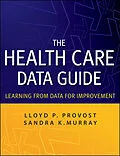The Health Care Data Guide is designed to help students and professionals build a skill set specific to using data for improvement of health care processes and systems. Even experienced data users will find valuable resources among the tools and cases that enrich The Health Care Data Guide. Practical and step-by-step, this book spotlights statistical process control (SPC) and develops a philosophy, a strategy, and a set of methods for ongoing improvement to yield better outcomes.
Provost and Murray reveal how to put SPC into practice for a wide range of applications including evaluating current process performance, searching for ideas for and determining evidence of improvement, and tracking and documenting sustainability of improvement. A comprehensive overview of graphical methods in SPC includes Shewhart charts, run charts, frequency plots, Pareto analysis, and scatter diagrams. Other topics include stratification and rational sub-grouping of data and methods to help predict performance of processes.
Illustrative examples and case studies encourage users to evaluate their knowledge and skills interactively and provide opportunity to develop additional skills and confidence in displaying and interpreting data.
Companion Web site: www.josseybass.com/go/provost
Autorentext
Lloyd P. Provost is a cofounder of Associates in Process Improvement, the developers of the Model for Improvement roadmap and the Quality as a Business Strategy template for focusing organizations on improvement. Lloyd is a senior fellow at the Institute for Healthcare Improvement, where he supports the use of data for learning in programs.
Sandra K. Murray is a principal in Corporate Transformation Concepts, an independent consulting firm. She is faculty for the Institute for Healthcare Improvement's year-long Improvement Advisor Professional Development Program and their Breakthrough Series College. Sandra has taught numerous programs through the National Association for Healthcare Quality. Her active cohort of client organizations encompasses the spectrum of health care delivery.
Inhalt
Figures, Tables, and Exhibits xi
Preface xxv
The Authors xxix
Part I Using Data for Improvement 1
Chapter 1 Improvement Methodology 3
Fundamental Questions for Improvement 4
What Are We Trying to Accomplish? 5
How Will We Know That a Change Is an Improvement? 6
What Changes Can We Make That Will Result in Improvement? 7
The PDSA Cycle for Improvement 8
Tools and Methods to Support the Model for Improvement 11
Analysis of Data from PDSA Cycles 18
Chapter 2 Using Data for Improvement 25
What Does the Concept of Data Mean? 25
How Are Data Used? 26
Types of Data 32
The Importance of Operational Definitions 37
Data for Different Types of Studies 40
Use of Sampling 42
What About Sample Size? 45
Stratification of Data 49
What About Risk or Case-Mix Adjustment? 51
Transforming Data 52
Analysis and Presentation of Data 58
Using a Family of Measures 61
Chapter 3 Understanding Variation Using Run Charts 67
Introduction 67
What Is a Run Chart? 67
Use of a Run Chart 68
Constructing a Run Chart 69
Examples of Run Charts for Improvement Projects 70
Probability-Based Tests to Aid in Interpreting Run Charts 76
Special Issues in Using Run Charts 85
Stratification with Run Charts 99
Using the Cumulative Sum Statistic with Run Charts 101
Chapter 4 Learning from Variation in Data 107
The Concept of Variation 107
Depicting Variation 110
Introduction to Shewhart Charts 113
Interpretation of a Shewhart Chart 116
Establishing and Revising Limits for Shewhart Charts 121
When Do We Revise Limits? 124
Stratification with Shewhart Charts 126
Rational Subgrouping 128
Shewhart Charts with Targets, Goals, or Other Specifications 131
Special Cause: Is It Good or Bad? 133
Other Tools for Learning from Variation 136
Chapter 5 Understanding Variation Using Shewhart Charts 149
Selecting the Type of Shewhart Chart 149
Shewhart Charts for Continuous Data 152
I Charts 152
Examples of Shewhart Charts for Individual Measurements 155
Rational Ordering with an Individual Chart 158
Effect of the Distribution of the Measurements 158
Example of Individual Chart for Deviations from a Target 159
X and S Shewhart Charts 160
Shewhart Charts for Attribute Data 163
The P Chart for Classification Data 166
C and U Charts for Counts of Nonconformities 173
Process Capability 184
Process Capability from an I Chart 186
Capability of a Process from X and S Chart (or R chart) 187
Capability of a Process from Attribute Control Charts 188
Capability from a P Chart 188
Capability from a C or U Chart 189
Appendix 5.1 Calculating Shewhart Limits 192
I Chart 192
X and S Charts 193
X and S Control Chart Calculation Form 195
P Chart 197
P Chart Calculation Form: Constant Subgroup Size 197
P Chart Calculation Form: Variable Subgroup Size 198
C Chart 199
U Chart 200
Chapter 6 Shewhart Chart Savvy: Dealing with Some Issues 201
Designing Effective Shewhart Charts 201
Tip 1: Type of Data and Subgroup Size 201
Tip 2: Rounding Data 202
Tip 3: Formatting Charts 202
Typical Problems with Software for Calculating Shewhart Charts 207
Characteristics to Consider When Purchasing SPC Software 211
Some Cautions When Using I Charts 211
Part II Advanced Theory and Methods with Data 217
Chapter 7 More Shewhart-Type Charts 219
Other Shewhart-Typ...
